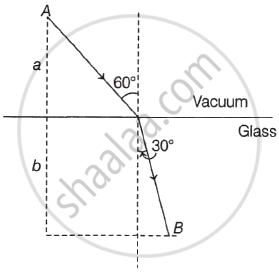Advertisements
Advertisements
प्रश्न
State any one difference between interference of light and diffraction of light
उत्तर
| Interference | Diffraction |
| Interference is the result of the superposition of different waves | Diffraction is the result of the superposition of the light wave of the different part of the same wavefront. |
| Interference fringes are of the same width | Diffraction fringes are not of the same width |
| All the bright bands of equal intensity | The intensity of the central maximum is the highest and the secondary maximum are of decreasing intensities. |
| The regions of minimum intensities are dark. |
The region of minimum intensities is not perfectly dark. |
| Both dark and bright bands are equally spaced. |
Dark bands on either side of the central bands are equally spaced but bright bands are not equally spaced |
| Large numbers of the band are obtained | Few bands are obtained |
| Resolving power of optical instrument is not related to interference. |
Resolving power of optical instrument is related to diffraction |
APPEARS IN
संबंधित प्रश्न
A long narrow horizontal slit is paced 1 mm above a horizontal plane mirror. The interference between the light coming directly from the slit and that after reflection is seen on a screen 1.0 m away from the slit. Find the fringe-width if the light used has a wavelength of 700 nm.
In Young’s double slit experiment, the slits are separated by 0.5 mm and screen is placed 1.0 m away from the slit. It is found that the 5th bright fringe is at a distance of 4.13 mm from the 2nd dark fringe. Find the wavelength of light used.
Why are multiple colours observed over a thin film of oil floating on water? Explain with the help of a diagram.
How do source and images behave as coherent sources?
Two independent monochromatic sources cannot act as coherent sources, why?
Light of wavelength 600 nm that falls on a pair of slits producing interference pattern on a screen in which the bright fringes are separated by 7.2 mm. What must be the wavelength of another light which produces bright fringes separated by 8.1 mm with the same apparatus?
Two identical light waves having phase difference 'Φ' propagate in same direction. When they superpose, the intensity of the resultant wave is proportional to ______.
In Young's experiment for the interference of light, the separation between the silts is d and the distance of the screen from the slits is D. If D is increased by 0.6% and d is decreased by 0.2%, then for the light of a given wavelength, which one of the following is true?
"The fringe width ____________."
In a biprism experiment, D = 1 m, `lambda` = 6000 Å. When a convex lens is interposed between the biprism ru1d the eyepiece, then the distance between the images of the slits given by the Jens at two positions are 1.5 mm and 6.0 mm. The fringe width will be ______.
A ray of light AO in vacuum is incident on a glass slab at angle 60° and refracted at angle 30° along OB as shown in the figure. The optical path length of light ray from A to B is ______.

